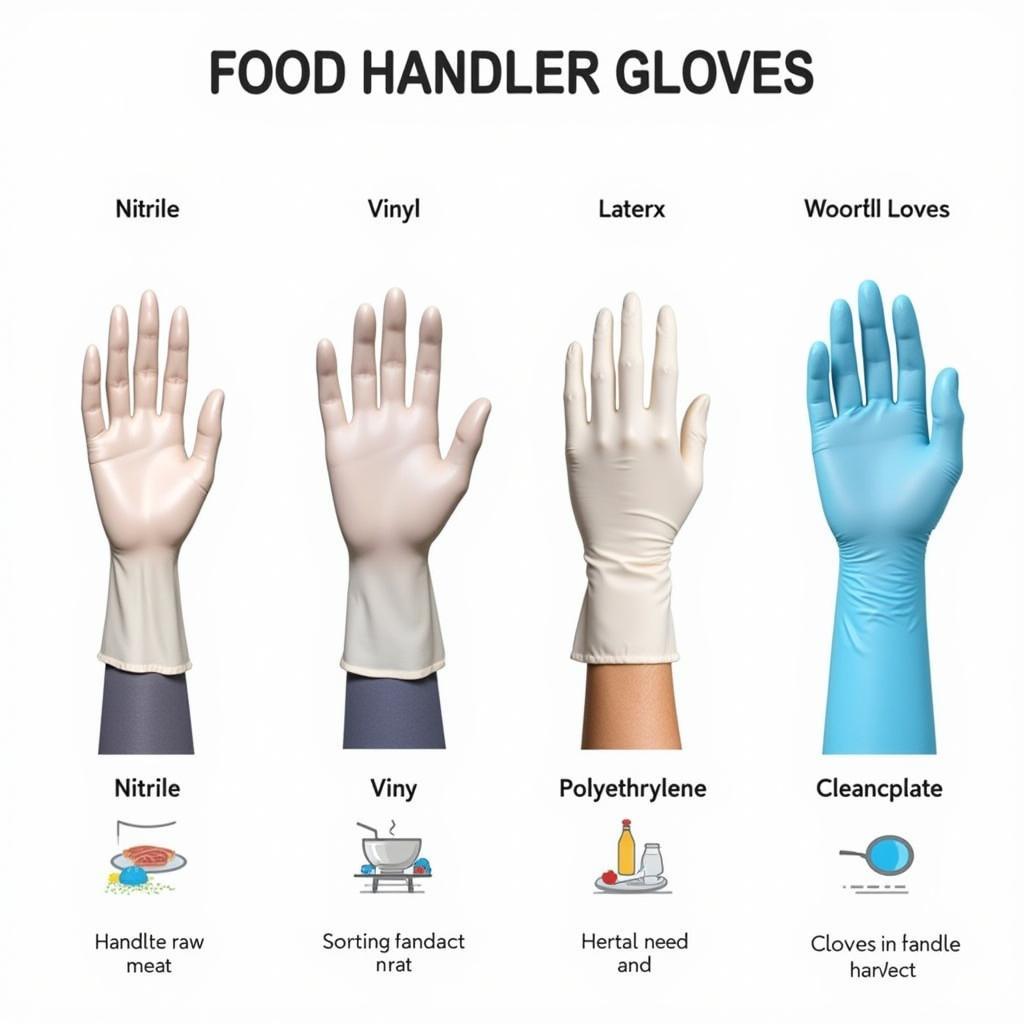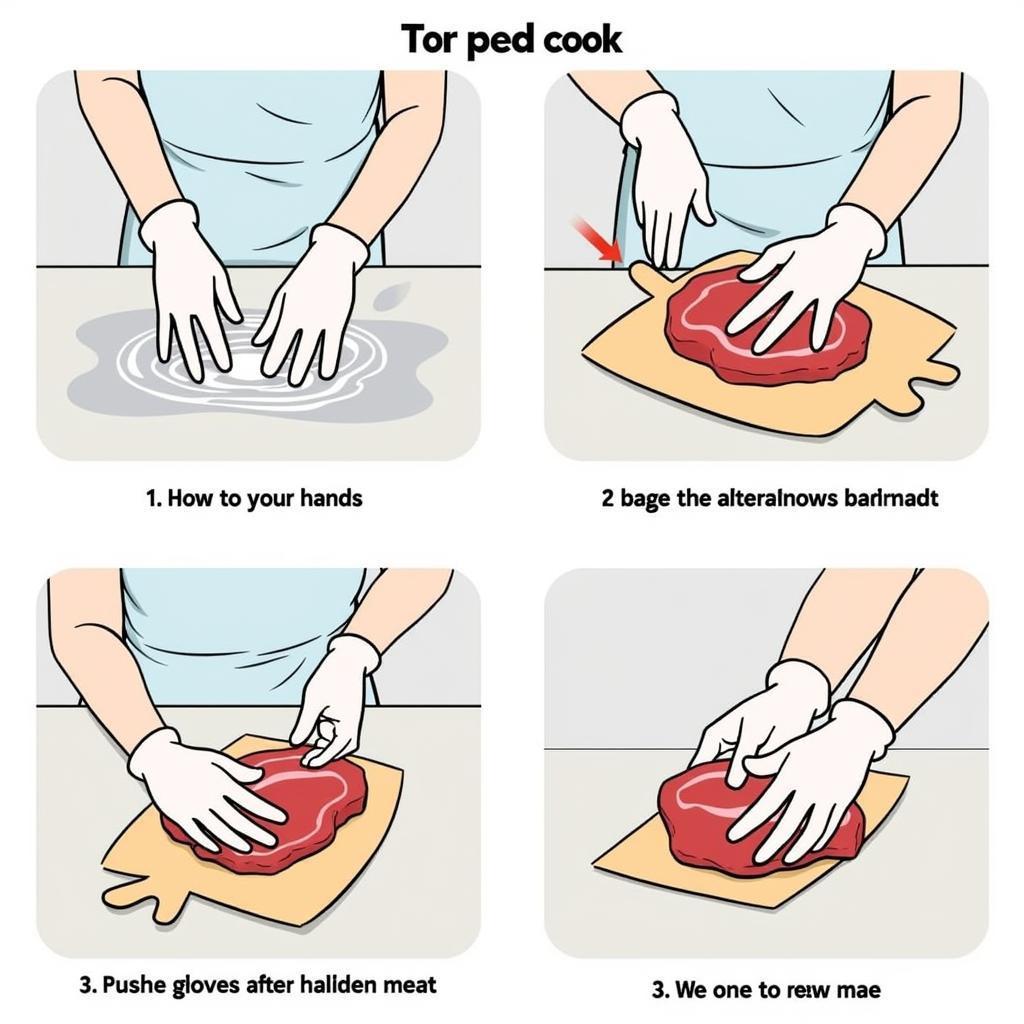Food Handler Gloves are an essential tool in maintaining food safety and hygiene. They act as a barrier between your hands and the food you’re preparing, preventing the spread of harmful bacteria and keeping your customers safe and healthy. But with so many options available, how do you choose the right gloves for your needs? This comprehensive guide will explore everything you need to know about food handler gloves, from choosing the right material to proper usage and disposal.
Choosing the Right Food Handler Glove Material
The material of your food handler gloves plays a crucial role in their effectiveness and suitability for various tasks. Let’s delve into the most common types:
-
Nitrile: Known for their durability, puncture resistance, and chemical resistance, nitrile gloves are an excellent choice for handling a wide range of food items. They’re also latex-free, making them a safe option for individuals with allergies. If you’re looking for comprehensive resources on food handling, the texas food managers exam answers might be helpful.
-
Vinyl: A more economical option, vinyl gloves offer decent protection against low-risk contaminants. They are a good choice for tasks that don’t involve handling raw meat or oily foods. However, they are less durable than nitrile and can tear more easily.
-
Latex: Offering excellent dexterity and sensitivity, latex gloves were once a popular choice. However, due to the increasing prevalence of latex allergies, their use in food service has declined.
-
Polyethylene: Commonly used for short-duration tasks, polyethylene gloves are lightweight and disposable. They are suitable for tasks like serving food or handling pre-packaged items. They offer minimal protection against bacteria and should not be used for handling raw foods.
 Food Handler Glove Materials: Nitrile, Vinyl, Latex, and Polyethylene
Food Handler Glove Materials: Nitrile, Vinyl, Latex, and Polyethylene
Proper Usage and Disposal of Food Handler Gloves
Using food handler gloves correctly is just as important as choosing the right material. Here’s a step-by-step guide:
- Wash your hands: Always wash your hands thoroughly with soap and water before putting on gloves.
- Choose the right size: Gloves that are too tight can tear easily, while gloves that are too loose can compromise dexterity.
- Change gloves frequently: Change gloves whenever they become soiled, torn, or after handling raw meat or poultry. You might find information related to food handling permits in Utah useful: food handlers permit answers utah.
- Avoid cross-contamination: Don’t touch ready-to-eat foods with gloves that have been used to handle raw meat or other potential contaminants.
- Remove gloves carefully: Avoid touching the outside of the gloves when removing them. Wash your hands thoroughly after removing gloves. For Spanish speakers, texas food handler español offers helpful resources.
 Proper Food Handler Glove Usage: Handwashing, Changing Gloves, Avoiding Cross-Contamination
Proper Food Handler Glove Usage: Handwashing, Changing Gloves, Avoiding Cross-Contamination
Why are Food Handler Gloves Important?
Food handler gloves are essential for preventing the spread of foodborne illnesses. They create a barrier between your hands and the food, reducing the risk of contamination.
When Should I Change My Gloves?
Change your gloves frequently, especially after handling raw meat, poultry, or any potentially contaminated items. Also, change them if they become torn or soiled. For those involved in food processing, finding reliable suppliers is crucial, check out resources on food processing supplies.
Food Handler Glove Regulations and Best Practices
Understanding local regulations regarding food handler gloves is paramount for ensuring compliance. While specific guidelines can vary, certain best practices are universally applicable.
“Proper glove use isn’t just about following the rules,” says renowned food safety consultant, Dr. Amelia Sanchez, “it’s about creating a culture of safety and prioritizing the well-being of your customers.”
Always check with your local health department for specific requirements. Additionally, consider implementing a comprehensive food safety training program for your staff. If you’re in Fresno and need a food handler card, food handlers card fresno offers helpful information.
Conclusion
Food handler gloves are a cornerstone of food safety. By choosing the right material, using them correctly, and adhering to best practices, you can significantly reduce the risk of foodborne illnesses and protect your customers. Remember, investing in quality food handler gloves and proper training is an investment in the health and well-being of your community.
FAQ
- Are food handler gloves required by law? Regulations vary by location, so check with your local health department.
- What are the best gloves for handling raw meat? Nitrile gloves are recommended due to their durability and puncture resistance.
- How often should I change my gloves? Change gloves whenever they become soiled, torn, or after handling raw meat or poultry.
- Can I wash and reuse food handler gloves? No, food handler gloves are designed for single use.
- What are the symptoms of a latex allergy? Symptoms can range from skin irritation to difficulty breathing.
- What should I do if I accidentally touch a contaminated surface with my gloves? Immediately remove the gloves, wash your hands thoroughly, and put on a new pair of gloves.
- Where can I buy food handler gloves? Food handler gloves are readily available at restaurant supply stores, janitorial supply stores, and online retailers.
Need support? Contact us at Phone Number: 02437655121, Email: [email protected] Or visit our address: 3PGH+8R9, ĐT70A, thôn Trung, Bắc Từ Liêm, Hà Nội, Việt Nam. We have a 24/7 customer support team.